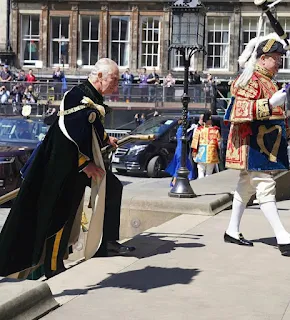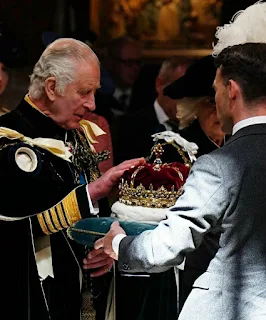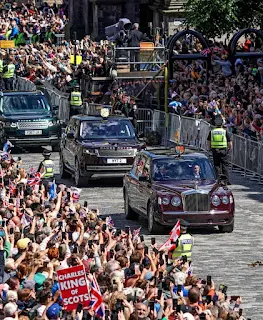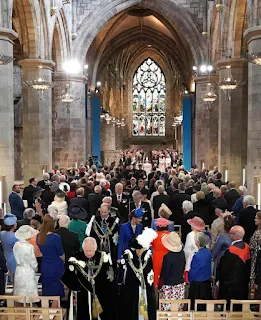On July 5, 2023, Scotland, one of the constituent countries of the United Kingdom, hosted its own event to honor the new monarch, King Charles III. It was a continuation of His Majesty's effort to foster ties with the people of the four nations that make up the United Kingdom.
Popularly referred to as a “second coronation,” the ceremony at St Giles’ Cathedral, however, was not officially a coronation but more of a National Service of Thanksgiving as King Charles was presented with the Honors of Scotland — the crown, the scepter and the sword of state — items he received with reverence during a service at St. Giles’ Cathedral. The Stone of Destiny, an important symbol of Scottish identity, was also moved to the cathedral for the festivities.
 |
| His Majesty King Charles III. Photo credit: Chris Jackson |
Their Majesties were accompanied by The Duke and Duchess of Rothesay (the official titles of the Prince and Princess of Wales when they are in Scotland). Both the King, Queen, and Prince William donned regalia of the Knight of Thistle (Scotland's highest and oldest honor of chivarly). Queen Camilla was just admitted into the Order by her husband prior to the Coronation.
 |
| King Charles received the Crown Jewels of Scotland Photo credit: Chris Jackson |
The special event was celebrated with festivities unique to Scotland - Bagpipes, kilts, drums and a Shetland pony named Corporal Cruachan IV marched down Edinburgh’s Royal Mile to honor King Charles III.
The presence of these icons of Scotland’s nationhood is a mark of respect for a country that is fiercely proud of its history and where the desire of some for independence has never died, even though it has been bound to England and the United Kingdom since 1707.
 |
| The King and Queen and the Duke of Rothesay wearing their Knight of Thistle regalia, while the Duchess of Rothesay wore a Catherine Walker blue coat dress. Photo credit: Reuters/Pool/AP |
King Charles was also presented with a new sword made by Scottish artisans and named after Elizabeth. The sword will be used in place of the current sword of state, which was made in 1507 and is too fragile for use in the ceremony.
Thousands lined Edinburgh’s Royal Mile to watch the parade and cheer for the new King and Queen as they traveled to and from the cathedral under sparkling sunny skies.
What are the Honors of Scotland
The Honors of Scotland are the most important pieces of the Scottish royal regalia and include a crown, scepter, and sword made of gold, silver, and precious gems. They are currently stored away at Edinburgh Castle and will be escorted to the royal procession by military and police.
 |
| Scottish Crown Jewel. Photo credit: Chris Jackson |
Dating back to the early 16th century, the Crown of Scotland was first worn by King James V of Scotland at the coronation of nine-month-old Queen Mary of Guise in 1540.
The Honors were locked away in a chest when the English and Scottish Parliaments united under the Act of Union of 1707, which brought together the independent kingdoms of England and Scotland under Great Britain. They were rediscovered in 1818 by the famous novelist Walter Scott.
During Wednesday’s ceremony, the Stone of Scone, also known as the Stone of Destiny, which was used as a seat in the coronation of Scottish kings for centuries, will also be present. It was last carried down to London from Scotland during King Charles’ coronation at Westminster Abbey in May.
 |
| Their Majesties The King and Queen Photo credit: Reuters/Pool/AP |
Notably, a new Sword of State called The Elizabeth will be presented to the King as a “symbol of Scotland.” The sword was commissioned to replace the original Sword of State, also known as the Papal sword, which is believed to be a papal gift from Pope Alexander VI to King James IV in 1494. The original sword can no longer be used at public events because of its delicate condition.
 |
| The Duke and Duchess of Rothesay during the service Photo credit: Reuters/Pool/AP |
“The Honors of Scotland have immense historical significance, having been present at many major ceremonial events over the past five hundred years,” Humza Yousaf said in his statement. “Designed and crafted with care by some of Scotland’s finest artisans, the Elizabeth Sword is a fitting tribute to the late Queen as Scotland prepares to welcome the new King and Queen next week.”
Most recently, the Scottish Crown was placed on Queen Elizabeth’s coffin during a service at St Giles’ Cathedral before her funeral last September.
 |
| The Duke and Duchess of Rothesay and Their Majesties. Photo credit: Reuters/Pool/AP |
Independent Scotland
Ironically, Scotland’s national government is led by the Scottish National Party, which is calling for a second independence referendum. And not everyone in the street was celebrating for the newly crowned King and Queen.
 |
| Royal procession in Edinburgh. Photo credit: Reuters/Pool/AP |
Our Republic, which campaigns for an elected head of state in Scotland, staged a protest outside the Scottish parliament, and shouts of “Not our king” were picked up by microphones as Charles left the cathedral.
“Charles is having ANOTHER Coronation, this time in Edinburgh. Another pointless parade, another reckless waste of public money. So, of course, we’ll be protesting it,” it stated on its website.
“The vast majority of Scotland didn’t care to celebrate the coronation in May, with support for the monarchy at an all-time low in Scotland,” the group said in a statement. “Charles’ perpetual need to celebrate his reign, with all the pomp and pageantry it requires, is a spit in the face to the people struggling with the cost of living.”
 |
| Anti-monarchist outside St. Giles' Church in Edinburgh. Photo credit: Danny Lawson—Pool/AFP/Getty Images |
Founded in 1983 as an umbrella group of anti-monarchists, Republic is a pressure group calling for an end to the U.K.’s system of constitutional monarchy and to replace the monarch with an elected head of state.
Previously, the group protested the royal wedding of Prince William and Kate Middleton in 2011 and Prince Harry and Meghan Markle’s wedding in 2018.
The latest opinion polls reflect declining support for the monarchy since the death of the late Queen Elizabeth II, and Charles’ personal approval rating has scarcely matched that of his mother.
Historically an independent country, Scotland was first linked to England in 1603 after the death of Queen Elizabeth I and the English throne was passed to her nearest blood relative, King James VI of Scotland, initiating the unification of Scotland and England.
But Scotland remained independent until 1707 when lawmakers in both countries approved the Act of Union, which created the United Kingdom.







0 Comments